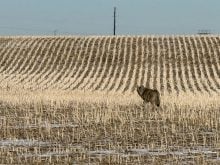Manitoba producers began digging in their heels last week at the
prospect of having their farms placed under greater government scrutiny
to help satisfy environmental goals.
Environment is included as one of the five pillars in the proposed
agricultural policy framework Ottawa unveiled earlier this year.
Attached to the environment pillar is the prospect that farms across
Canada will have to go under the microscope to see if they pose risks
to the environment.
Claire De’Athe, a Carberry, Man. cattle producer, called the government
Read Also

Agritechnica Day 2: The future of tractor power, building quicker crop apps and large farms and tech
Agritechnica Day 2: The future of tractor power, building quicker crop apps with Syngenta and large farms and tech
direction discriminatory because it seems to point the finger at
agriculture, without looking more closely at other things such as
municipal landfills and lagoons.
“This is not farm planning. This is discrimination against
agriculture,” she said.
The environmental aspect of the agriculture policy framework was
debated at length during a general council meeting of Keystone
Agricultural Producers Oct. 24.
Farmers are concerned about the ambiguity surrounding the environment
pillar and the degree of scrutiny that farmers can expect from it.
They want evidence that it will benefit the farming community rather
than adding more costs and paperwork to their operations.
“I think we have to see the benefits flow to the farmer, not only to
society,” said Duncan Broadfoot, a producer from Gladstone, Man.
KAP members endorsed a position paper on the issue last week that took
those concerns into account.
It was noted that the federal government once stated that within five
years every farm in Canada would have an environmental farm plan in
place.
According to KAP, that position has since been changed to state that
farms would undergo an “environmental farm scan.” On farms where risk
was revealed by the scans, an environmental farm plan would have to be
developed.
Before government pushes in that direction, KAP wants a review of all
the environmental controls and programs directed at farmers.
“Such an evaluation would highlight any gaps that exist,” said the
Manitoba farm group’s position paper, “but we can say with much
certainty that many of our current practices fulfil any perceived gaps
that an environmental farm plan may address.”
Manitoba does not have its own model of what an environmental farm plan
would look like for producers. However, some producers at last week’s
KAP meeting held the view that it is only a matter of time before
tighter controls are brought to Manitoba.
“This isn’t something we can walk away from,” said Ian Wishart, a
Portage la Prairie producer and a national committee member of the
environment pillar.
Not all producers were against the idea of environmental farm plans.
Murray McCallum, a producer near Brandon, said he would welcome them.
He noted that the day may come when lending institutions shy away from
producers who lack some form of accreditation to demonstrate that the
environmental risks on their farms are minimal.
KAP president Weldon Newton warned the issue is not confined only to
livestock operations. He noted that grain farms will also come under
increased scrutiny, partly because they store things like fuel,
fertilizer and herbicides.














